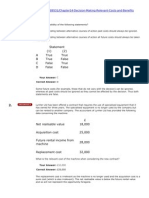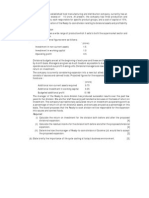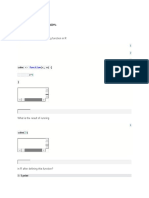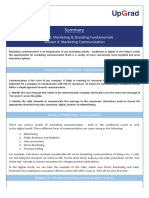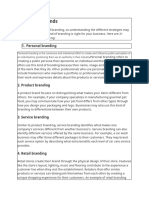Cost Accounting Quiz Answers
Cost Accounting Quiz Answers
Uploaded by
Glessey Mae Baito LuvidicaCopyright:
Available Formats
Cost Accounting Quiz Answers
Cost Accounting Quiz Answers
Uploaded by
Glessey Mae Baito LuvidicaOriginal Title
Copyright
Available Formats
Share this document
Did you find this document useful?
Is this content inappropriate?
Copyright:
Available Formats
Cost Accounting Quiz Answers
Cost Accounting Quiz Answers
Uploaded by
Glessey Mae Baito LuvidicaCopyright:
Available Formats
SURIGAO EDUCATION CENTER MIDTERM QUIZ 2 – ANSWER KEY
Accountancy Program Instructor: Jean Pearl I. Millones, CPA
Theory Questions
1/10. e. All of the above methods are acceptable approaches to accounting for by-products.
2/11. c. The primary reason for allocating joint costs is for inventory valuation for financial reporting.
3/12. a. materials, labor, and overhead
4/13. d. constant gross margin percentage method.
5/14 . a. net realizable value method.
6/15 . a. a by-product.
7/16 . e. All of the methods are acceptable under GAAP.
8/17. D. split-off point.
9/18. A. relative-sales-value method.
10/19. B. Relative-sales-value method.
Ratcliff Company produces two products from a joint process: X and Z. Joint processing costs for this production cycle
are $8,000.
Disposal
Sales price cost per Further Final sale
per yard at yard at processing price per
Yards split-off split-off per yard yard
X 1,500 $6.00 $3.50 $1.00 $ 7.50
Z 2,200 9.00 5.00 3.00 11.25
If X and Z are processed further, no disposal costs will be incurred or such costs will be borne by the buyer.
11. Refer to Ratcliff Company. Using a physical measure, what amount of joint processing cost is allocated to X (round
to the nearest dollar)?
ANS: D
1,500/3,700 * $8,000 = $3,243
12. Refer to Ratcliff Company. Using a physical measure, what amount of joint processing cost is allocated to Z (round
to the nearest dollar)?
2,200/3,700 * $8,000 = $4,757
ANS: D
13. Refer to Ratcliff Company. Using sales value at split-off, what amount of joint processing cost is allocated to X
(round to the nearest dollar)?
ANS: B
Sales price
Yards at Split-off Total
X 1,500 $6.00 $ 9,000
Y 2,200 $9.00 $19,800
$28,800
$(9,000/28,800) * $8,000 = $2,500
14. Refer to Ratcliff Company. Using sales value at split-off, what amount of joint processing cost is allocated to Z
(round to the nearest dollar)?
ANS: A
Sales price
Yards at Split-off Total
X 1,500 $6.00 $ 9,000
Y 2,200 $9.00 $19,800
$28,800
$(19,800/28,800) * $8,000 = $5,500
15. Refer to Ratcliff Company. Using net realizable value at split-off, what amount of joint processing cost is allocated
to X (round to the nearest dollar)?
ANS: C
Sales Disposal NRV/
Yards price Cost/Yard Splitoff Total NRV
at Split-
off
X 1,500 $6.00 $3.50 $2.50 $ 3,750
Y 2,200 $9.00 $5.00 $4.00 $ 8,800
$12,550
$(3,750/12,550) * $8,000 = $2,390
16. Refer to Ratcliff Company. Using net realizable value at split-off, what amount of joint processing cost is allocated
to Z (round to the nearest dollar)?
ANS: D
Sales Disposal NRV/
Yards price Cost/Yard Splitoff Total NRV
at Split-
off
X 1,500 $6.00 $3.50 $2.50 $ 3,750
Y 2,200 $9.00 $5.00 $4.00 $ 8,800
$12,550
$(8,800/12,550) * $8,000 = $5,610
17. Refer to Ratcliff Company. Using approximated net realizable value at split-off, what amount of joint processing
cost is allocated to X (round to the nearest dollar)?
ANS: A
Separate
Final Cost per Net Approximated
Yards Sales Yard Sales NRV
Price Price
X 1,500 $ 7.50 $4.50 $3.00 $ 4,500
Y 2,200 $11.25 $8.50 $3.25 $ 7,150
$11,650
$(4,500/11,650) * $8,000 = $3,090
18. Refer to Ratcliff Company. Using approximated net realizable value at split-off, what amount of joint processing
cost is allocated to Z (round to the nearest dollar)?
ANS: B
Separate
Final Cost per Net Approximated
Yards Sales Yard Sales NRV
Price Price
X 1,500 $ 7.50 $4.50 $3.00 $ 4,500
Y 2,200 $11.25 $8.50 $3.25 $ 7,150
$11,650
$(7,150/11,650) * $8,000 = $4,910
19. Refer to Ratcliff Company. Which products would be processed further?
ANS: A only A
Incremental Incremental Net
Yards Revenues Costs Difference
X 1,500 $ 1.50 $1.00 $ 0.50
Y 2,200 $ 2.25 $3.00 $(0.75)
Butler Manufacturing Company makes three products: A and B are considered main products and C a by-product.
Production and sales for the year were: 220,000 lbs. of Product A, salable at $6.00
180,000 lbs. of Product B, salable at $3.00
50,000 lbs. of Product C, salable at $.90
Production costs for the year:
Joint costs $276,600
Costs after separation:
Product A 320,000
Product B 190,000
Product C 6,900
Required: Using the by-product revenue as a cost reduction and net realizable value method of assigning joint costs,
COMPUTE UNIT COSTS
(a) if C is a by-product of the process (6 points)
ANS:
a. JOINT COST $276,600
- NRV C (38,100) (50,000 - $.90) - $ 6,900
TO ALLOCATE $238,500
SALES VALUE - COST AFTER SEPARATION = NRV
220,000 $6 = $1,320,000 - $320,000 = $1,000,000
180,000 $3 = $ 540,000 - $190,000 = 350,000
$1,350,000
ALLOCATION
$1,000,000/$1,350,000 $238,500 = $176,667
$ 350,000/$1,350,000 $238,500 = 61,833
$238,500
UNIT COST:
A ($176,667 + $320,000)/220,000 = $2.26
B ($61,833 + $190,000)/180,000 = $1.40
Notes:
In computing the Net Realizable Value at Split-Off, no further processing costs will be incurred since it will be sold as is.
Therefore, the SEPARABLE COST related to this method is only the disposal cost.
*Sales Value at Split-Off – Separable Cost
NRV at Split-Off = Sales Value at Split-off – Disposal Cost
In Computing the Approximated Net Realizable Value, further processing costs and disposal costs will be incurred and
shall both form part of the separable costs.
*Sales Value at Split-Off – Separable Cost
Approximated NRV = Ultimate Selling Price - Further Processing Costs - Disposal Cost
You might also like
- Assignment 1 - 2021 - 2022Document4 pagesAssignment 1 - 2021 - 2022Assya El MoukademNo ratings yet
- Planning Plant ProductionDocument10 pagesPlanning Plant ProductionjokoNo ratings yet
- Rel Costing RevDocument5 pagesRel Costing RevJenicareen Eulalio67% (3)
- Cost-Volume-Profit Analysis Lecture Notes With ProbsDocument6 pagesCost-Volume-Profit Analysis Lecture Notes With ProbsShaika Haceena100% (1)
- Chapter 6 - Solution ManualDocument29 pagesChapter 6 - Solution Manualjuan100% (2)
- Alternate Demonstration Problem MerchandisingDocument5 pagesAlternate Demonstration Problem MerchandisingmoNo ratings yet
- ME401T CAD Ellipse Algorithm - 5Document29 pagesME401T CAD Ellipse Algorithm - 5AnuragShrivastavNo ratings yet
- Macro Environment of The Mobile IndustryDocument2 pagesMacro Environment of The Mobile IndustryAbhinandanMalhotraNo ratings yet
- POM Facility LocationDocument35 pagesPOM Facility LocationPankaj PantNo ratings yet
- Akan M Et Al Fundamentals of Finance Investments Corporate FDocument428 pagesAkan M Et Al Fundamentals of Finance Investments Corporate Fscience.dataNo ratings yet
- Chapters 1 To 3 (Answers)Document8 pagesChapters 1 To 3 (Answers)Cho AndreaNo ratings yet
- Integrated and Non Integrated Accounting System: Amazing Journey of Logic and ConceptsDocument17 pagesIntegrated and Non Integrated Accounting System: Amazing Journey of Logic and ConceptsSafal BhandariNo ratings yet
- Flexible Budget N Overhead VarianceDocument16 pagesFlexible Budget N Overhead Variancenotes.mcpuNo ratings yet
- Different Question: Conduct The 5-Step Test For This ExerciseDocument6 pagesDifferent Question: Conduct The 5-Step Test For This ExerciseTun TaiNo ratings yet
- FinalexamDocument14 pagesFinalexamSureshNo ratings yet
- Final Thesis For Publishing Zenaw HailemariamDocument79 pagesFinal Thesis For Publishing Zenaw HailemariamTesema GenetuNo ratings yet
- Susquehanna Equipment Rentals General Journal (Adjusting Entries)Document1 pageSusquehanna Equipment Rentals General Journal (Adjusting Entries)Miles LinNo ratings yet
- R35 Capital Budgeting Q BankDocument15 pagesR35 Capital Budgeting Q BankAhmedNo ratings yet
- Chapter 5 - Decision Making and R-Information-sem II 2018Document16 pagesChapter 5 - Decision Making and R-Information-sem II 2018Yonas100% (1)
- Financial Management-Capital Budgeting:: Answer The Following QuestionsDocument2 pagesFinancial Management-Capital Budgeting:: Answer The Following QuestionsMitali JulkaNo ratings yet
- Pre-Feasibility Study: Social Media Marketing AgencyDocument21 pagesPre-Feasibility Study: Social Media Marketing AgencyNauman QureshiNo ratings yet
- IPE 336 - Session 2014Document10 pagesIPE 336 - Session 2014ridoy2146No ratings yet
- QuestionsDocument16 pagesQuestionsአረጋዊ ሐይለማርያም100% (1)
- Activity Based Costing Test QuestionsDocument5 pagesActivity Based Costing Test QuestionsMehul GuptaNo ratings yet
- SEATWORKDocument4 pagesSEATWORKMarc MagbalonNo ratings yet
- Excercise 5,6Document4 pagesExcercise 5,6sume shquidecNo ratings yet
- ProductivityDocument17 pagesProductivitygetahun2001100% (1)
- Sinclair Company Group Case StudyDocument20 pagesSinclair Company Group Case StudyNida AmriNo ratings yet
- Lecture#4 Midpoint Ellipse Drawing AlgorithmDocument19 pagesLecture#4 Midpoint Ellipse Drawing AlgorithmfuxailNo ratings yet
- CH 11Document51 pagesCH 11Nguyen Ngoc Minh Chau (K15 HL)No ratings yet
- Ratios Analysis Notes AND ONE SOLVED QUIZDocument6 pagesRatios Analysis Notes AND ONE SOLVED QUIZDaisy Wangui100% (2)
- Project Analysis Chapter SixDocument6 pagesProject Analysis Chapter Sixzewdie100% (1)
- Economic Order Quantity (EOQ) - Practical Problems and SolutionsDocument18 pagesEconomic Order Quantity (EOQ) - Practical Problems and SolutionsahmedNo ratings yet
- Winter 2007 Midterm With SolutionsDocument13 pagesWinter 2007 Midterm With Solutionsupload55No ratings yet
- Chapter 2 - Demand and SupplyDocument64 pagesChapter 2 - Demand and SupplyNetsanet MeleseNo ratings yet
- Target CostDocument5 pagesTarget CostWarda RizviNo ratings yet
- Performance 6.10Document2 pagesPerformance 6.10George BulikiNo ratings yet
- Quiz 3 CADocument30 pagesQuiz 3 CAbasilnaeem7No ratings yet
- OT Practice Exercise-1Document3 pagesOT Practice Exercise-1Savita Choudhary0% (1)
- Managerial Accounting Chapter 5 by GarrisonDocument4 pagesManagerial Accounting Chapter 5 by GarrisonJoshua Hines100% (1)
- Chapter 7 LeverageDocument21 pagesChapter 7 Leveragemuluken walelgnNo ratings yet
- PROCESSDocument16 pagesPROCESSAsmita RangariNo ratings yet
- ADL 01 Assignment ADocument5 pagesADL 01 Assignment Aversha2950% (2)
- Solved ProblemsDocument24 pagesSolved ProblemsSammir MalhotraNo ratings yet
- 10 - SolAccounting Basic QuestionsDocument4 pages10 - SolAccounting Basic Questionssneha patelNo ratings yet
- Assignment 2Document4 pagesAssignment 2Wu JingNo ratings yet
- (Team 1) Case Study Joan HoltzDocument5 pages(Team 1) Case Study Joan HoltzAlyssa San FelipeNo ratings yet
- Week 2 Quiz: Latest Submission Grade 100%Document8 pagesWeek 2 Quiz: Latest Submission Grade 100%Kei RyNo ratings yet
- Lecture 10 - Financial Statement AnalysisDocument35 pagesLecture 10 - Financial Statement AnalysisTabassum Sufia MazidNo ratings yet
- Operating Costing PresentationDocument18 pagesOperating Costing PresentationMahfuzulNo ratings yet
- Mis Assignment FinalDocument24 pagesMis Assignment FinalDigambar LohakareNo ratings yet
- Group Five Research ProposalDocument16 pagesGroup Five Research ProposalYenew AyenewNo ratings yet
- Demand Curve Mangerial AssignmentDocument3 pagesDemand Curve Mangerial AssignmentAgumas AlehegnNo ratings yet
- MakeORBuy NumericalsDocument6 pagesMakeORBuy Numericalsgurjit20No ratings yet
- FA2II AssignementDocument10 pagesFA2II AssignementkiduseNo ratings yet
- Decoding DCF: A Beginner's Guide to Discounted Cash Flow AnalysisFrom EverandDecoding DCF: A Beginner's Guide to Discounted Cash Flow AnalysisNo ratings yet
- Value Chain Management Capability A Complete Guide - 2020 EditionFrom EverandValue Chain Management Capability A Complete Guide - 2020 EditionNo ratings yet
- Corporate Financial Analysis with Microsoft ExcelFrom EverandCorporate Financial Analysis with Microsoft ExcelRating: 5 out of 5 stars5/5 (1)
- Pricing and Cost Accounting: A Handbook for Government ContractorsFrom EverandPricing and Cost Accounting: A Handbook for Government ContractorsNo ratings yet
- Britni Johnson: Purdue University, West Lafayette, inDocument2 pagesBritni Johnson: Purdue University, West Lafayette, inbritnijohnsonNo ratings yet
- Brand Equity A Study of Mysore Silk PrimDocument12 pagesBrand Equity A Study of Mysore Silk Primvmanjunath_joge6646No ratings yet
- Terminology Test - Trial Balance and Financial StatementsDocument2 pagesTerminology Test - Trial Balance and Financial StatementsStars2323No ratings yet
- Bamboo Lamp: Presentation OnDocument19 pagesBamboo Lamp: Presentation OnMd Rifat MotalebNo ratings yet
- Generally Accepted Accounting Principles EssayDocument3 pagesGenerally Accepted Accounting Principles EssayScribdTranslationsNo ratings yet
- In AccointDocument57 pagesIn AccointTuan Anh TranNo ratings yet
- Entrep9 Q2 1st TopicDocument12 pagesEntrep9 Q2 1st TopicRochelleNo ratings yet
- MKTG 1421 - Consumer Psychology & Behaviour: Topic 7: Post-Purchase Processes, Customer Satisfaction and LoyaltyDocument40 pagesMKTG 1421 - Consumer Psychology & Behaviour: Topic 7: Post-Purchase Processes, Customer Satisfaction and LoyaltyQuan NguyenNo ratings yet
- PLM LECTURES COST ACCOUNTING-GLORIA RANTE - Doc1Document13 pagesPLM LECTURES COST ACCOUNTING-GLORIA RANTE - Doc1Angelita Alonzo57% (7)
- The Factors of Financial Performance of Smes (Case of Vietnam)Document15 pagesThe Factors of Financial Performance of Smes (Case of Vietnam)HT BerdNo ratings yet
- WebandsocialDocument6 pagesWebandsocialDheeraj JakkuvaNo ratings yet
- Case 2-1 - Solution: Estimated Time To Complete This Case Is Two HoursDocument10 pagesCase 2-1 - Solution: Estimated Time To Complete This Case Is Two HoursLavanya TadepalliNo ratings yet
- MBA Students Thesis 2005Document11 pagesMBA Students Thesis 2005rajansingh52No ratings yet
- 2001 Decmenber (Question)Document6 pages2001 Decmenber (Question)Luke Wan0% (1)
- Introduction To Currency Asian Option ValuationDocument17 pagesIntroduction To Currency Asian Option ValuationMichael TaylorNo ratings yet
- Upgrad Course Summary - DM - M1 - S4Document2 pagesUpgrad Course Summary - DM - M1 - S4Govind BatraNo ratings yet
- EOS Group 5 Sec B - DiaperDocument11 pagesEOS Group 5 Sec B - DiaperYOGAKSHEM 01No ratings yet
- Addition and Subtraction - PIE - 6th May 2024Document6 pagesAddition and Subtraction - PIE - 6th May 2024Noori ShaikNo ratings yet
- INREV NAV - INREV GuidelinesDocument1 pageINREV NAV - INREV GuidelinesLYNo ratings yet
- Strategic ManagementDocument6 pagesStrategic ManagementFelix Jimmy MuchaNo ratings yet
- 21 Types of BrandsDocument5 pages21 Types of BrandsSaram KhanNo ratings yet
- Capacity Utilization Adjustment For Fixed Personnel Cost A Practical ApproachDocument2 pagesCapacity Utilization Adjustment For Fixed Personnel Cost A Practical ApproachGabriela MaierNo ratings yet
- Chapter 4 SolutionsDocument11 pagesChapter 4 Solutionskadir.danismentNo ratings yet
- Unit 6: Porters Generic Strategy & Value ChainDocument47 pagesUnit 6: Porters Generic Strategy & Value ChainRajeshree JadhavNo ratings yet
- ECO-201 Final Paper TemplateDocument12 pagesECO-201 Final Paper TemplateAhmed AwaisNo ratings yet
- Hidalgo Kimberly Midterm HW1Document37 pagesHidalgo Kimberly Midterm HW1Eunie AquinoNo ratings yet
- Work 2 Joshi ClassDocument6 pagesWork 2 Joshi ClassSatyajeet RananavareNo ratings yet
- DISSERTATION by Naman DaveDocument35 pagesDISSERTATION by Naman DaveAMITY UNIVERSITY AhmedabadNo ratings yet


